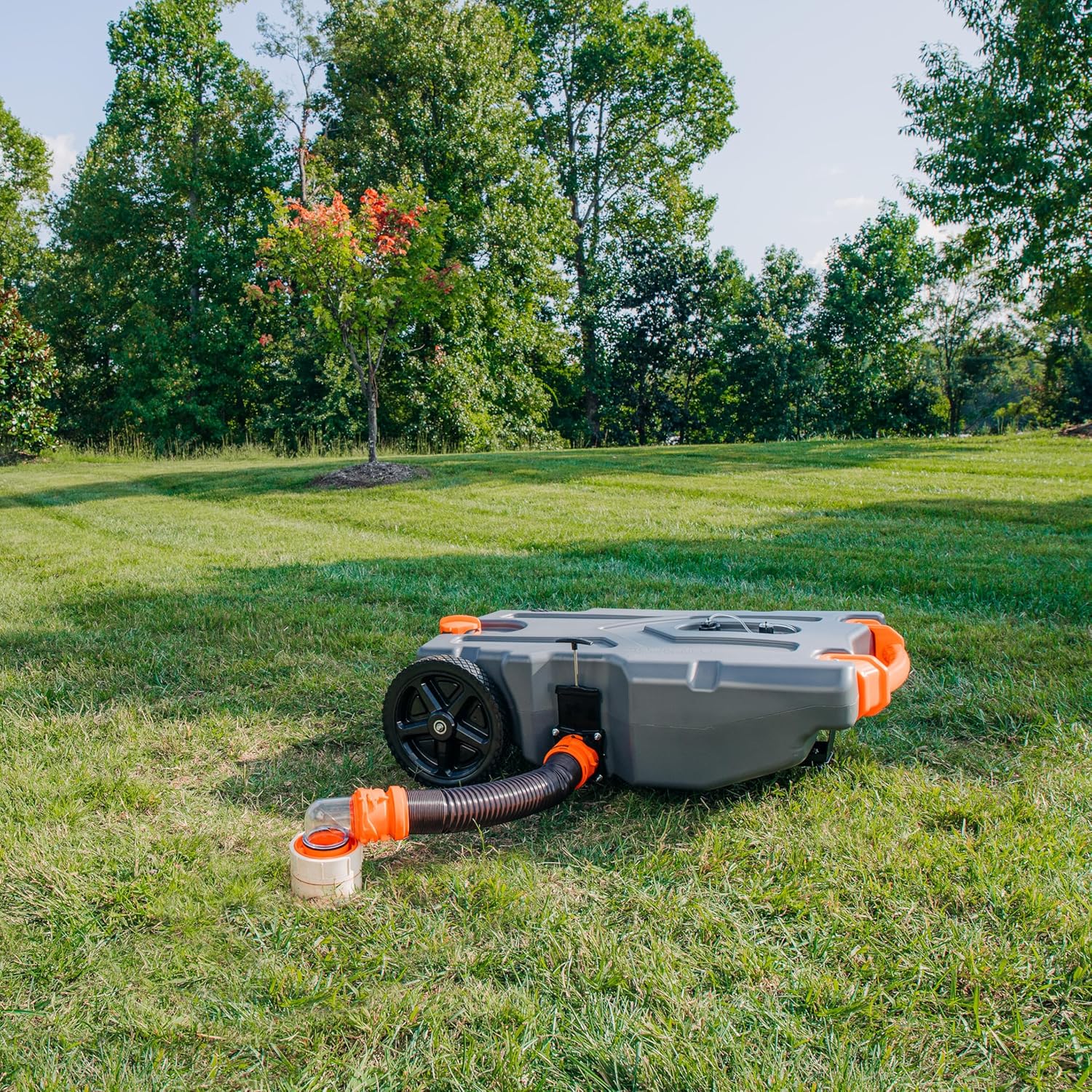? Looking for a reliable, user-friendly way to haul and empty your RV black water when your sewer hose can’t quite reach the dump station?
Camco Rhino 36-Gallon Portable RV Tote Tank – Features 2 Steerable No-Flat Front Wheels & Built-in Gate Valve – Includes Removable 24″ Tow Bar, 3’ Sewer Hose & More RV Accessories (39007)
You’ll find this tote tank marketed to make RV waste management straightforward, especially when you’re parked a distance from the dump. The full product name is a mouthful, but it tells you the key selling points: a large 36-gallon capacity, steerable non-flat front wheels, heavy-duty rear wheels, a built-in gate valve, and a package of accessories designed to get you up and running immediately.
Camco Rhino 36-Gallon Portable RV Tote Tank - Features 2 Steerable No-Flat Front Wheels & Built-in Gate Valve - Includes Removable 24
First impressions
When you first get your hands on the Camco Rhino 36-Gallon Portable RV Tote Tank, you’ll notice the tank’s solid heft and well-considered design. The molded HDPE looks like it can take knocks and sun exposure without complaint, and the accessories included mean you can get started right away.
Key features
This section highlights the major features that will matter most during regular use. You’ll want to understand capacity, mobility, the valve and rinser setup, and what accessories come in the kit so you can evaluate whether this tank fits your routines.
Capacity & dimensions
The tank holds 36 gallons and measures about 24 1/8″ L x 14 3/4″ W x 44 7/8″ H. That compact footprint makes it easier to store and maneuver than some larger tote tanks while still giving you enough buffer for a couple days of full RV use, depending on how many people are on board.
Wheels & mobility
You’ll appreciate the two 6″ steerable no-flat front wheels and the pair of 12″ heavy-duty no-flat rear wheels with bearings. The steerable front wheels make the tank easy to pull around campsites and parking lots, while the larger rear wheels help you handle uneven terrain without tipping or dragging.
Construction & durability
The body is made from UV-stabilized blow-molded HDPE and is built to resist sun damage and weathering. You’ll see this translates into a tank that doesn’t feel flimsy when you move it, and the plastic’s finish suggests it will resist cracking and yellowing over time.
Patented design & origin
Rhino Tote Tanks are made in the USA and use a patented design. If you prioritize American manufacturing or want assurance of a certain build quality, this is one of the features that will reassure you.
Gate valve & tank rinser
A built-in gate valve provides a quick, reliable way to empty the tank without tipping it excessively. The included tank rinser helps you perform a more thorough cleaning after dumping, so you won’t be reaching for additional tools every time.
Kit accessories
The kit bundles a useful collection of fittings and hoses: a 3′ sewer hose with swivel fittings, a 15″ water hose rinse adapter, a clear elbow with 4-in-1, a clear double bayonet elbow, multiple storage caps, caps with lanyards, and a steel tow adapter. You’ll appreciate how much thought went into including items you’d likely buy separately otherwise.
Product specifications table
Here’s a quick breakdown to make the important numbers and components easy to scan. This table will help you compare specs at a glance and confirm the tank matches your RV’s setup.
| Item | Specification / Details |
|---|---|
| Capacity | 36 gallons |
| Tank dimensions | 24 1/8″ (L) x 14 3/4″ (W) x 44 7/8″ (H) |
| Weight (empty) | Approximately 55 lb |
| Material | UV-stabilized blow-molded HDPE |
| Front wheels | (2) 6″ steerable no-flat wheels with bearings |
| Rear wheels | (2) 12″ heavy-duty no-flat wheels with bearings |
| Tow bar | Removable 24″ steel tow adapter included |
| Gate valve | Built-in gate valve for easy emptying |
| Accessories included | 3′ sewer hose w/swivel fittings, 15″ rinse adapter, clear elbow w/4-in-1, clear double bayonet elbow, 4 storage caps, 2 caps with lanyards, steel tow adapter |
| Extras | Tank rinser, ladder hook, grooves for tie-down straps |
| Country of manufacture | USA (patented design) |
Unboxing and setup
When you open the box, you’ll find most parts already assembled or simply snapped into place for quick setup. The larger pieces like wheels and tow adapter will typically require a few bolts or quick clips, and the instructions are straightforward so you won’t be stuck guessing.
What’s in the box
You’ll receive the main tote tank, the 3′ sewer hose, the tow bar, rinse adapter, elbow fittings, caps, and the steel tow adapter among other small parts. Every essential item you need for basic operation is included, so you won’t have to stop and buy adapters unless your RV has an unusual setup.
Assembly & initial checks
Assembly generally involves slipping the wheels into position, securing the tow adapter, and attaching the ladder hook or any caps. You’ll want to check that the gate valve moves freely, that the sealing caps sit flush, and that the wheels spin without rubbing against the tank body.
Using the tote tank with your RV
You’ll use this tank as an extension of your RV’s sewer system when distance or elevation prevents direct hook-up. The objective is to make the transfer of black water clean, secure, and as hands-off as possible.
Connecting to the RV
Attach the 3′ sewer hose to your RV’s outlet using the provided clear elbows or bayonet fittings; the swivel fittings help prevent twisting. You’ll want to confirm a snug fit to prevent leaks during transfer, and you can use the clear elbows to see the flow as you dump.
Filling process
Position the tote tank downhill or somewhere stable and open the gate valve on your RV to let the contents flow into the tank; you’ll want to keep an eye on the tank’s capacity so you don’t overfill. A slow fill is easier to manage, and because the tank is tall rather than wide, you can often get a few additional gallons tucked in before reaching the top.
Transporting & towing
For longer distances you can attach the 24″ steel tow adapter and tow the tote behind a truck or golf cart, or pull it manually using the oversized handle. The steerable front wheels reduce the turning radius, and the heavy rear wheels help you cross gravel, grass, or packed dirt without trouble.
Emptying at the dump station
Hook the gate valve up to the dump station or simply empty directly into the inlet by opening the built-in gate valve. The smooth interior and the rinser let you perform a final cleanse in the station’s bay with minimal back-and-forth.
Cleaning and maintenance
Keeping the tank clean protects your gear and helps prevent odors and buildup. You’ll find a few simple routines will keep this tote in top shape for many seasons.
Using the tank rinser and rinse adapter
The included 15″ water hose rinse adapter fits onto common hose spigots so you can blast the interior while rotating the tank. You’ll want to use a long rinse and perhaps a bit of RV-safe cleaner if you notice residue forming, then allow the interior to dry completely before storage to reduce odors.
Exterior care and checks
Wipe down the exterior after heavy camp use and check the gate valve seals and caps periodically for cracks or wear. You’ll also want to inspect the wheel bearings and attachment points for rust or loosening, and tighten or grease them as needed.
Preventing odors
Flush the tank after every emptying and consider a short soak with an RV-safe enzymatic product every few trips. You’ll reduce the chance of lingering smells and keep seals from becoming brittle when exposed to waste by cleaning and drying thoroughly.
Performance observations
I’ll outline predictable performance in real-world situations so you can picture how the tank will behave across different use cases. You’ll get a sense of how the unit fares when fully loaded, how the wheels handle, and how easy it is to maintain sanitary conditions.
Maneuverability on different terrain
On packed campsites and pavement the steerable front wheels make single-person handling straightforward and relatively effortless. On uneven ground, the larger rear wheels keep the tank from wobbling and allow you to pull it without the front wheels sinking into soft soil.
Towing stability and safety
When you tow the tank behind a vehicle, the tow adapter and oversized handle create a secure connection and predictable path. You’ll still want to lock it down with tie-down straps in transit and avoid high speeds or rough roads that could stress the hitch or cause slosh.
Leak and seal reliability
The HDPE construction and included caps produce a reliable seal in everyday use, with the gate valve offering a solid closure when you’re moving between sites. You’ll want to inspect seals occasionally and replace caps or gaskets if you see wear, but in normal conditions leaks are uncommon.
Rinse efficiency
The built-in rinser and included rinse adapter make internal cleaning efficient, and the smooth interior reduces clinging solids. With a few minutes of rinsing after dumping you’ll see that the tank returns to a near-new state internally, which saves time and reduces odor.
Storage and mounting options
You’ll likely need to store the tote either on the RV, in a compartment, or hanging off a ladder; this tank is designed with storage flexibility in mind. The ladder hook and tie-down grooves make it easy to secure the tank safely for storage or transit.
Ladder hook and strap grooves
Use the ladder hook to hang the tank vertically from your camper ladder when space is tight; the hook fits most ladders and keeps the tank off the floor. The grooves in the tank body accept tie-down straps so you can secure it in truck beds or compartments without improvising.
Stowing the 3′ sewer hose and accessories
The 3′ sewer hose compresses for storage and the smaller fittings and caps can be kept in a storage bin or clipped together for convenience. You’ll find the included caps with lanyards useful so you won’t lose them between uses.
Tips for compact storage
When you store the tank, keep it standing upright in a dry place and avoid prolonged sun exposure even though it’s UV-stabilized. You’ll extend the life of seals and plastic by keeping the tank covered or inside a compartment if possible.
Maintenance and long-term care
If you want this tote to last many seasons, a small amount of regular maintenance goes a long way. You’ll follow most of the standard care for plastic tanks and moveable hardware.
Wheel and bearing upkeep
Check wheel bearings periodically and re-grease if you notice stiffness or squeaking. You’ll also inspect the wheel housings and fasteners for signs of corrosion or loosening, then tighten hardware as needed.
Gate valve and cap maintenance
Make sure the gate valve operates smoothly and doesn’t leak; use silicon grease appropriate for rubber seals if it becomes stiff. For caps and fittings, replace worn gaskets and keep spare caps close so you aren’t stranded without proper sealing.
Winterizing
If your climate drops below freezing, you’ll want to store the tank empty and dry, and keep it indoors to prevent freeze damage to the gate valve and any residues. You’ll also want to drain and dry hose fittings and store them in a dry place.
Pros & Cons
You’ll get a quick list of major advantages and potential drawbacks so you can decide whether this tank matches your priorities and campsite habits.
Pros:
- Large 36-gallon capacity suits longer stops or families.
- Steerable front wheels and heavy rear wheels make maneuvering easy on varied surfaces.
- Built-in gate valve and rinser simplify dumping and cleaning.
- Includes a comprehensive accessory kit so you can start using it immediately.
- Durable, UV-stabilized HDPE construction designed for outdoor use.
- Made in the USA with a patented design offering reliable craftsmanship.
Cons:
- Weighs about 55 lb empty, so initial setup and lifting may be awkward for some users.
- Tall, narrow profile requires attentive securing during transport to prevent tipping.
- The kit’s 3′ sewer hose works for close transfers only; you may need an extension for certain situations.
- Tow adapter requires secure mounting and caution when towing at speed.
Comparison to other portable tote tanks
You’ll find similar tote tanks on the market with varying wheel setups, materials, and accessory bundles. Compared with models that come with inflatable wheels or cheaper plastic, the Camco Rhino stands out for its no-flat wheels, heavier duty build, and bundled accessories.
How it stacks up on price vs. value
While some less expensive tote tanks will undercut Camco in price, you’ll often pay later either in replacement wheels, additional adapters, or reduced longevity. The bundled extras and build quality on the Rhino often justify the upfront cost if you plan to use the tank frequently over several seasons.
When other options might make sense
If you only need occasional short transfers or you prefer a collapsible solution for ultra-compact storage, a lightweight or foldable tank from other brands might be better. You’ll choose the Rhino when durability, frequent use, and towing capability are priorities.
Who should buy this
You should consider this tank if you spend nights at campgrounds where the dump station isn’t directly adjacent to your site. If you often need to tow a waste tank behind a vehicle, navigate rough surfaces, or want a durable kit that includes most necessary fittings, this model is aimed at you.
Ideal scenarios
Couples or families who stay multiple nights in places without convenient dump access will benefit from the 36-gallon capacity. You’ll also find it useful if you boondock often and need a reliable way to hold and transport waste safely to the nearest dump.
When to look for alternatives
If you’re a solo traveler who only stays one night per campsite or you want the smallest possible footprint for storage, a smaller or collapsible tank might be a better fit. You’ll also consider other options if you need a tank that fits into a very specific compartment shape.
Troubleshooting common issues
If you run into small problems, a few simple steps usually solve them quickly without sending the tank back to the manufacturer. You’ll appreciate that most fixes are straightforward and require basic tools or inexpensive replacement parts.
If you notice leaks
First check all caps and gaskets for proper seating and signs of wear. Tighten fittings and replace worn seals if leaking persists; leaks are usually caused by a misaligned cap or a damaged gasket rather than the tank body itself.
If wheels feel stiff or hard to steer
Inspect the wheel bearings and axle mounts for dirt, rust, or loose bolts. Clean, lubricate, and tighten hardware as needed; replacing a worn bearing is usually straightforward and inexpensive.
If the gate valve sticks
Operate the valve a few times after cleaning it and apply an appropriate seal lubricant if it’s stiff. If the valve shows cracks or persistent leaks, contact manufacturer support for replacement parts.
Frequently asked questions
Below are common questions you might have and concise answers so you can be confident before you buy.
Can you tow this behind a golf cart or ATV?
Yes, the removable 24″ steel tow adapter is designed to allow towing behind trucks, golf carts, and similar vehicles; you’ll still want to secure the tank with tie-downs while in transit. Keep towing speeds moderate and check local rules about towing wastewater containers in your area.
Is the tank leakproof?
In normal use the tank is leakproof when you ensure caps and gaskets are in good condition and fittings are securely attached. Perform a simple water test after purchase to confirm seals before using it with waste.
How easy is it to clean?
Cleaning is straightforward thanks to the smooth interior surface and the included tank rinser; you’ll usually get the tank clean with a hose and a short scrub. Using RV-safe enzymatic cleaners periodically will keep odors at bay and reduce buildup.
Will it fit under my RV or in my storage compartment?
Because the tank is tall and narrow, you’ll need to measure your compartments or storage areas to be sure it fits standing or lying down. You’ll often find it easiest to store upright on a ladder hook or in an exterior compartment with tie-downs.
Can the steered wheels be locked?
The front wheels are steerable for maneuverability but are not typically lockable like a caster brake; however, using a tie-down strap or chock when parked prevents unwanted rolling. You’ll want to support the tank if it’s on a slope.
Accessories and add-ons you might consider
You’ll probably be fine with the included kit for many uses, but over time you may want to purchase a few extras to make operation even smoother.
- Longer sewer hose if your dump station inlet sits farther away than 3′.
- Extra replacement caps and gaskets for quick field repairs.
- A small pump or macerator if you prefer active pumping over gravity flow for speed.
- A storage bag or cover to keep the tank clean and shaded when not in use.
Final verdict
If you need a durable, well-equipped portable tank that’s easy to maneuver and built to last, the Camco Rhino 36-Gallon Portable RV Tote Tank (39007) is a strong choice. You’ll appreciate the combination of capacity, mobility, included accessories, and a design that focuses on making waste transfer and cleaning less of a hassle, especially for frequent RVers and families.
Disclosure: As an Amazon Associate, I earn from qualifying purchases.













